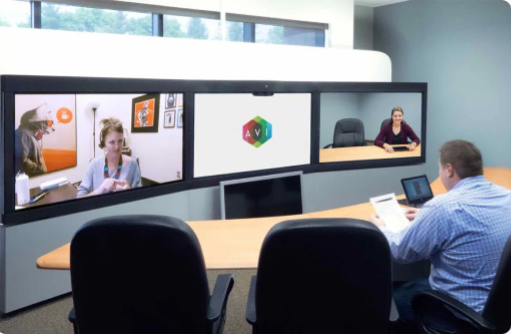It’s scientifically proven that meeting fatigue, or more commonly Zoom fatigue, exists.
Since the beginning of the pandemic, Microsoft has commissioned surveys with Harris Poll, undergone scientific studies of the brain, held focus groups, conducted interviews and more than 30 research projects.
Among the findings, Microsoft reported that the brain is stressed. “Specifically, brainwave patterns associated with stress and overwork were much higher when collaborating remotely than in-person,” writes Jared Spataro, Corporate Vice President for Microsoft 365, in a report.
Stress begins to set in after 30 minutes of remote collaboration and only two hours into the workday — leaving a mountainous six more hours to go. But what’s the root cause?
Research suggests its multiple factors, including:
- Meetings increased by roughly 8% and feature more participants prior to the pandemic; people also fail to schedule breaks between meetings
- Technical features in video conferencing platforms that can add stress, like how grid view splits the brain’s focus or when participants’ windows are minimized during content sharing
- Intensified concentration to pick up subtle cues and non-verbal communication, which would normally come organically during in-person meetings
“For somebody who’s really dependent on non-verbal cues, it can be a big drain not to have them,” said Andrew Franklin, an assistant professor of cyberpsychology at Virginia’s Norfolk State University, in an article.
After months on end of what feels like non-stop video calls, some people feel the burnout creeping in. This affects their engagement during calls and productivity at work.
While there are many solutions to combat these feelings and symptoms, the truth is virtual meetings are here to stay.
While 100% remote work appears to have an end, it won’t go away completely. The remote workforce will transition to a hybrid one in the coming months, featuring a blend of in-person and remote collaboration.
But how can remote workers combat meeting fatigue? How can they improve their virtual meetings and enhance remote productivity?
You will read about several strategies to improve virtual meetings below.
Are Your End Users Struggling with Virtual Meetings? Pass Along These Best Practices
While the reasons vary, meeting fatigue has begun to set in. And when meetings fail to engage participants, it costs organizations in more ways than one. So, what’s the best way to fix this?
1 Take Full Advantage of Unified Collaboration Platforms
By some estimates, participants waste up to 15% of meeting time because they struggle with technology — either it doesn’t work, or worse, it's not intuitive.
To account for this, some experts say presenters should plan for their virtual meetings to run 25% longer. But during a time of constant meetings and a longer workday, the focus should be on running meetings more efficiently, not adding more time.
Achieving this starts by knowing the technology inside and out — from the foundational features to the most advanced.
As IT leaders bring on new video conferencing and collaboration technology and retire outdated platforms — from antiquated software to old meeting room equipment — they must help their workforce better understand the tools that empower them to continue collaborating, especially as tech companies roll out new features.
Microsoft introduced new functionality to Teams, like Focus Mode, which allows users to remove distractions from their interface while others share content. Both Microsoft and Zoom also rolled out real-time closed captioning to make their platforms more accessible.
As these products mature, new and improved features will enable more effective communication among a hybrid workforce, but IT must maintain a responsibility to teach its organization about to take full advantage of the technology.
3 ways IT can help its workforce with new and existing technology:
- Host live virtual training sessions and Q&As
- Double-down on communications with workers
- Build out a resource center that highlights advanced technical features of tools and platforms
2 Establish Interoperability Between Video Conferencing Platforms
Over two-thirds of enterprise companies rely on more than one video conferencing platform. Whether it’s Zoom and Teams or Webex and BlueJeans, or any other combination, most commit to more than one tool.
And, that makes sense.
Organizations work with many stakeholders outside of the company, including contractors, partners, and others who might not use the same platform given the range of solutions available on the market.
But surely, the solution isn’t to subscribe to each online video conferencing platform. Right? Right.
Instead, IT can make its organization’s chosen platforms interoperate with others. Zoom, Microsoft and Webex announced last year plans to establish interoperability among their platforms, so no matter which video conferencing tool users joined from, they would have a seamless experience.
As users better understand new and existing platforms, interoperability would make it easier for them to join meetings from a familiar interface, rather than learning multiple platforms all at once.
By using a cloud video interop (CVI) solution from one of the leading providers — think: Microsoft, Poly, and others — IT can create an easier way for people to meet with others, regardless of the platform.
3 Set a Goal and Have an Agenda for Each Virtual Meeting
“If I don’t have an agenda in front of me, I walk out,” Annette Catino, chief executive of the QualCare Alliance Network, told the New York Times. In essence, Catino says if there isn’t an agenda, there isn’t a meeting.
Wasted time because of meetings accounts for a resounding $30 billion dollars annually in the U.S. For every meeting, define a goal and use the agenda as a road map to reach it. An agenda will also help meetings start and end on time, focusing participants on the work at hand.
The meeting host should provide everyone with an agenda to ground the conversation and provide structure to the call. This is especially important for virtual meetings, given the way they tend to stack up on people’s schedules and cut into work time.
Without clear lanes, virtual meetings can drag on, provide less-than-favorable results, and result in disengaged participants. What’s more, consider ending meetings early if time allows. Given the way meetings have increased and tend to stack up, the refunded time would be a welcome gift that allows people to recharge between meetings.
4 Every Meeting Participant Leaves with Homework
At the beginning of every meeting, there should be a goal and an agenda. By the time the meeting ends, participants must have homework.
A contributing factor to meeting apathy derives from people’s attitudes toward meetings.
Was it worth it? Was it a waste of time? What’s the point?
If meeting participants leave the call, thinking it could’ve been an email — or worse — they won’t be as ambitious to meet again next time. Instead, meeting participants should feel energized, with a clear action plan for once they hang up.
Some organizations adopted terminology that’s now ingrained into their meetings.
Mark Toro, managing partner of North American Properties – Atlanta, told the New York Times how the acronym “W.W.D.W.B.W.” became a staple part of meeting culture at the real estate company. It stands for “Who will do what by when?” At the end of every meeting, it’s a consistent response to wrap the call and assign homework to every participant.
5 Create a Culture that Promotes Meeting Etiquette
The constant “shhhushing” and “can you please mute yourself” during virtual meetings cause needless disruption to what could be productive calls. As more distractions enter virtual meetings, it becomes harder for participants to readjust their focus, especially given their strained concentration.
To combat this, establish virtual meeting etiquette across the organization, including:
- Understand how to use the technology
- Assign someone as a moderator
- Mute all participants who aren’t presenting
- Encourage everybody to turn their video on
- Discourage people from multitasking
- Start and end meetings on time
Meetings will flow better, keep participants engaged, and lead to better results with proper etiquette in place. These actions become a part of an organization’s culture with repetition and consistency at all levels.
6 Consider a Work-From-Home Technology Kit
Poor audio, latency, and bad internet connections contribute to the negative qualities of meetings and exacerbate fatigue. If participants can’t hear one another — or even join the virtual meeting — productivity suffers.
IT professionals and business leaders should consider the need and cost of a work-from-home technology kit for remote and hybrid workers. Some organizations, like Google, offered their employees a stipend to purchase equipment while they work remotely.
From a technical perspective, a reliable internet connection, a high-quality headset or microphone and adequate lighting help to guarantee users experience a higher quality meeting.
Not only does this eliminate the degraded quality of virtual meetings, it levels the playing field for many employees. In Microsoft’s report, only 35% of workers have a dedicated home office, which leaves a substantial portion without an adequate environment.
7 Host More Inclusive Meetings
Of course, the consequences of poor meetings — in-person or virtual — exceed boredom, but that too is also quite prevalent. According to the Harvard Business Review, 90% of participants admitted to daydreaming during meetings, while 73% work on other projects during what should be collaboration time.
Perhaps part of the reason why so many have the time to daydream during meetings is because they don’t feel included in the conversation.
Much like in-person meetings, virtual calls can become overtaken by extroverts and the highest-ranking officials in the room. Unfortunately, everybody loses the chance to hear multiple perspectives when this happens — and isn’t that the reason for meetings in the first place?
To improve not only the quality of meetings but engagement as well, hosts should take these three actions to create an inclusive environment:
- Assign roles or jobs to individuals.
- Make time for everybody to contribute.
- Address people directly.
Communications platform Slack says the most engaging roles for participants are: interactive, straightforward and frequent. By giving an individual a role, it makes him or her an active participant at the meeting — which quells the ability to multitask.
However, a job doesn’t necessarily guarantee each meeting attendee speaks. During meetings at which the goal is to solicit feedback or opinions, carve out time for every participant to weigh in, regardless of their job title or status. Whether it’s a round-robin style approach or another, the purpose of this strategy is to keep participants engaged and help them feel like their time is highly valued.
That said, the meeting host should practice direct communication by setting ground rules at the beginning of the call, delegating meeting tasks, and calling on individuals by name.
Direct, clear communication eliminates response delays and awkward silences, which also contribute to Zoom fatigue, according to Dr. Jena Lee is Assistant Professor at the David Geffen School of Medicine at University of California at Los Angeles.
You’re Not Dreaming It — Virtual Meetings Increased During the Pandemic
For those opening their calendars to find an exhaustive list of back-to-back virtual meetings, at some point they will wonder if it’s always been this way.
Not so.
Virtual meetings increased during the pandemic and so has the workday (by approximately 48 minutes). It’s no wonder Zoom fatigue became the phenomenon that it has. But there are ways to combat the stressors of virtual meetings and improve them in the process.
IT professionals must lead by example and provide their workforce with the knowledge to enhance their virtual meetings. With these best practices, remote and hybrid workforces can stave off a virtual rut and spend their time more productively.












